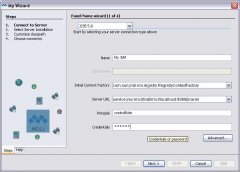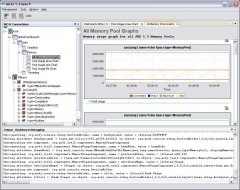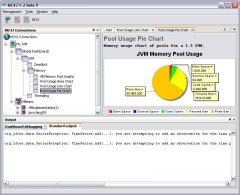Thomas Darimont
Erfahrenes Mitglied
Hallo!
Folgende JVM Arguemente müssen wir angeben:
unser Management Interface lassen wir auf dem Port 9999 lauschen...
Unser jmxremote.password schaut so aus:
Unser jmxremote.access file schaut so aus:
Beispiel wäre nun mal das remote monitoren von Eclipse... (ist ja nur ein beispiel ;-)
Dann kann man auch mit anderen Tools als der jconsole wie etwa dem netten MC4J (http://www.tutorials.de/tutorials231309.html&highlight=mc4j) die lokalen JVMs monitoren (Damit kann man mal den nervigen OOMEs innerhalb Eclipse 3.1.1 + WTP auf den Zahn fühlen...)
(Damit kann man mal den nervigen OOMEs innerhalb Eclipse 3.1.1 + WTP auf den Zahn fühlen...)
Gruss Tom
Ps.:
Frohe Weihnachten
Folgende JVM Arguemente müssen wir angeben:
Code:
-Dcom.sun.management.jmxremote.password.file=E:/stuff/jmxremote.password -Dcom.sun.management.jmxremote.access.file=e:/stuff/jmxremote.access -Dcom.sun.management.jmxremote.port=9999 -Dcom.sun.management.jmxremote -Dcom.sun.management.jmxremote.ssl=false -Dcom.sun.management.jmxremote.authenticate=trueunser Management Interface lassen wir auf dem Port 9999 lauschen...
Unser jmxremote.password schaut so aus:
Code:
# ----------------------------------------------------------------------
# Template for jmxremote.password
#
# o Copy this template to jmxremote.password
# o Set the user/password entries in jmxremote.password
# o Change the permission of jmxremote.password to read-only
# by the owner.
#
# See below for the location of jmxremote.password file.
# ----------------------------------------------------------------------
##############################################################
# Password File for Remote JMX Monitoring
##############################################################
#
# Password file for Remote JMX API access to monitoring. This
# file defines the different roles and their passwords. The access
# control file (jmxremote.access by default) defines the allowed
# access for each role. To be functional, a role must have an entry
# in both the password and the access files.
#
# Default location of this file is $JRE/lib/management/jmxremote.password
# You can specify an alternate location by specifying a property in
# the management config file $JRE/lib/management/management.properties
# or by specifying a system property (See that file for details).
##############################################################
# File permissions of the jmxremote.password file
##############################################################
# Since there are cleartext passwords stored in this file,
# this file must be readable by ONLY the owner,
# otherwise the program will exit with an error.
#
# The file format for password and access files is syntactically the same
# as the Properties file format. The syntax is described in the Javadoc
# for java.util.Properties.load.
# Typical password file has multiple lines, where each line is blank,
# a comment (like this one), or a password entry.
#
#
# A password entry consists of a role name and an associated
# password. The role name is any string that does not itself contain
# spaces or tabs. The password is again any string that does not
# contain spaces or tabs. Note that passwords appear in the clear in
# this file, so it is a good idea not to use valuable passwords.
#
# A given role should have at most one entry in this file. If a role
# has no entry, it has no access.
# If multiple entries are found for the same role name, then the last one
# is used.
#
# In a typical installation, this file can be read by anybody on the
# local machine, and possibly by people on other machines.
# For # security, you should either restrict the access to this file,
# or specify another, less accessible file in the management config file
# as described above.
#
# Following are two commented-out entries. The "measureRole" role has
# password "QED". The "controlRole" role has password "R&D".
#
# monitorRole QED
# controlRole R&D
monitorRole foobar
controlRole foobarUnser jmxremote.access file schaut so aus:
Code:
######################################################################
# Default Access Control File for Remote JMX(TM) Monitoring
######################################################################
#
# Access control file for Remote JMX API access to monitoring.
# This file defines the allowed access for different roles. The
# password file (jmxremote.password by default) defines the roles and their
# passwords. To be functional, a role must have an entry in
# both the password and the access files.
#
# Default location of this file is $JRE/lib/management/jmxremote.access
# You can specify an alternate location by specifying a property in
# the management config file $JRE/lib/management/management.properties
# (See that file for details)
#
# The file format for password and access files is syntactically the same
# as the Properties file format. The syntax is described in the Javadoc
# for java.util.Properties.load.
# Typical access file has multiple lines, where each line is blank,
# a comment (like this one), or an access control entry.
#
# An access control entry consists of a role name, and an
# associated access level. The role name is any string that does not
# itself contain spaces or tabs. It corresponds to an entry in the
# password file (jmxremote.password). The access level is one of the
# following:
# "readonly" grants access to read attributes of MBeans.
# For monitoring, this means that a remote client in this
# role can read measurements but cannot perform any action
# that changes the environment of the running program.
# "readwrite" grants access to read and write attributes of MBeans,
# to invoke operations on them, and to create or remove them.
# This access should be granted to only trusted clients,
# since they can potentially interfere with the smooth
# operation of a running program
#
# A given role should have at most one entry in this file. If a role
# has no entry, it has no access.
# If multiple entries are found for the same role name, then the last
# access entry is used.
#
#
# Default access control entries:
# o The "monitorRole" role has readonly access.
# o The "controlRole" role has readwrite access.
monitorRole readonly
controlRole readwriteBeispiel wäre nun mal das remote monitoren von Eclipse... (ist ja nur ein beispiel ;-)
Code:
eclipse -vmargs -Dcom.sun.management.jmxremote.password.file=E:/stuff/jmxremote.password -Dcom.sun.management.jmxremote.access.file=e:/stuff/jmxremote.access -Dcom.sun.management.jmxremote.port=9999 -Dcom.sun.management.jmxremote -Dcom.sun.management.jmxremote.ssl=false -Dcom.sun.management.jmxremote.authenticate=trueDann kann man auch mit anderen Tools als der jconsole wie etwa dem netten MC4J (http://www.tutorials.de/tutorials231309.html&highlight=mc4j) die lokalen JVMs monitoren
Gruss Tom
Ps.:
Frohe Weihnachten



